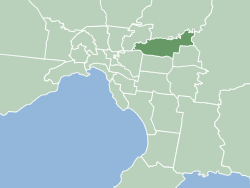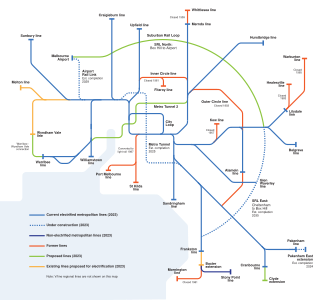
The City of Manningham is a local government area in Victoria, Australia in the north-eastern suburbs of Melbourne and is divided into 12 suburbs, with the largest being Doncaster and Doncaster East. It comprises an area of 113 square kilometres and had a population of 125,508 in June 2018.

Camberwell is a suburb of Melbourne, Victoria, Australia, 10 km east of Melbourne's Central Business District, located within the City of Boroondara local government area. Camberwell recorded a population of 21,965 at the 2021 census.

Docklands, also known as Melbourne Docklands, is an inner-city suburb in Melbourne, Victoria, Australia, 2 km (1.2 mi) west of Melbourne's Central Business District, located within the City of Melbourne local government area. Docklands recorded a population of 15,495 at the 2021 census.

Bulleen is an eastern suburb in Melbourne, Australia, 13 km north-east of the Melbourne central business district, located within the City of Manningham local government area. Bulleen recorded a population of 11,219 at the 2021 census.

Dandenong is a southeastern suburb of Melbourne, Victoria, Australia, about 35 km (22 mi) from the Melbourne CBD. It is the council seat of the City of Greater Dandenong local government area, with a recorded population of 30,127 at the 2021 census. Situated mainly on the northwest bank of the lower Dandenong Creek, it is 21.6 km (13.4 mi) from the eponymous Dandenong Ranges to its northeast and completely unrelated in both location and nature of the settlement.

Doncaster is a suburb of Melbourne, Victoria, Australia, 18 km north-east of Melbourne's Central Business District, located within the City of Manningham local government area. Doncaster recorded a population of 25,020 at the 2021 census.

Templestowe is a suburb of Melbourne, Victoria, Australia, 16 km north-east of Melbourne's Central Business District, located within the City of Manningham local government area. Templestowe recorded a population of 16,966 at the 2021 census.

Proposals for expansion of the Melbourne rail network are commonly presented by political parties, government agencies, industry organisations and public transport advocacy groups. The extensions proposed take a variety of forms: electrification of existing routes to incorporate them into the suburban rail system; reconstruction of former passenger rail lines along pre-existing easements; entirely new routes intended to serve new areas with heavy rail or provide alternative routes in congested areas; or track amplification along existing routes to provide segregation of services. Other proposals are for the construction of new or relocated stations on existing lines, to provide improved access to public transport services.

Westfield Doncaster is a shopping centre 50% owned by Scentre Group and 25% owned by ISPT and 25% owned by Asia Property Fund located in Doncaster, a suburb of Melbourne, Victoria, Australia. As of July 2014, the Westfield Group became two companies Scentre Group and Westfield Corporation. The Westfield Group portion is now owned by Scentre Group. It is located on the corner of Williamsons Road and Doncaster Road in the Doncaster Hill precinct, an ongoing planning initiative by the local Manningham council. It is located 20 minutes east of the CBD and is one of the biggest shopping centres in Victoria.
The Electoral district of Doncaster was a metropolitan electorate of the Victorian Legislative Assembly, located approximately 13 kilometres north-east of Melbourne. It was part of the Upper House Eastern Metropolitan Region and sat entirely within the City of Manningham. It was abolished and divided between the Electoral district of Bulleen and the Electoral district of Warrandyte The seat was abolished due to new boundary changes in preparation for the 2014 election.

Melbourne 2030 is a Government of Victoria strategic planning policy framework for the metropolitan area of Melbourne, Australia intended to cover the period 2001–2030. During this period the population of the metropolitan area is expected to grow by a million people to over five million. Population projections now predict Melbourne's population could reach seven million by that time and the government has since changed its strategy on the policy, abandoning the urban growth boundary in the north and west of Melbourne and reducing green wedges.
Urban consolidation describes the policy of constraining further development and population growth to within the boundaries of preexisting urban areas rather than expanding outward into suburban areas. Urban consolidation seeks to increase the population density of a given urban area by expanding upward, redeveloping preexisting buildings and lots, and constructing new facilities in available spaces. It is theorized that discouraging urban sprawl and encouraging further development of housing units in preexisting urban areas will lead to a net gain in social and economic prosperity.

The Doncaster railway line was a long-proposed suburban railway in the eastern suburbs of Melbourne, Victoria, Australia, that was anticipated to be built by the late 2020s, as a branch, along with the Hurstbridge line, of the planned future Clifton Hill Loop Line, as part of the 2013 PTV Network Development Plan.

Currawong Bush Park is a nature park located in the outer eastern Melbourne suburbs of Doncaster East, Warrandyte and Donvale, along Mullum Creek. It covers 59 hectares of remnant bushland and contains archaeological sites significant to the Traditional Owners of the area, the Wurundjeri people of the Kulin nation.
The Eddington Transport Report was a major transport study undertaken in Victoria, Australia, by infrastructure consultant Sir Rod Eddington to propose improvements to transport links between the eastern and western suburbs of Melbourne. The report, titled "Investing in Transport–East West Link Needs Assessment", was commissioned in 2006 by the Government of Victoria following the model of the Eddington Transport Study in the United Kingdom and was released in April 2008. Eddington's report recommended new road and rail tunnels, further rail network electrification and improved cycle and bus routes in a bid to reduce congestion. Some of the report's recommendations were implemented by the Brumby Labor government, but many others remained unfunded.
Numerous proposals have been made for improvements to the Melbourne tram network, the largest such network in the world. Nearly all of these have been for track extensions of existing lines to connect with nearby railway station or to service new areas and suburbs.

Melbourne Metro 2 (MM2) is a proposed extension to the Melbourne rail network, consisting of a tunnel from Newport to Clifton Hill via the city centre. Conceived as a follow-up project to the under-construction Metro Tunnel, MM2 would link the Werribee and Mernda suburban rail lines and include stations in the Fishermans Bend development precinct, at Southern Cross and at Parkville, allowing passengers to connect with Metro Tunnel and City Loop lines. Although MM2 has been proposed and refined by a number of government-led and independent reports and proposals, no funding or policy commitment to its planning or construction is in place as of 2022.

The urban renewal of Sydney is an ongoing land redevelopment process that is creating and reviving new urban centres across Sydney, Australia. Urban renewal refers to the refurbishment of derelict buildings, streets or neighbourhoods and is accompanied with the process of gentrification attributed by changes in land use and deindustrialisation of areas. In 2020, there are several projects underway and planned including Barangaroo, The Bays Precinct and Green Square.
The Eastern Busway is bus rapid transit line under construction in the eastern suburbs of Melbourne, Australia. It would operate alongside the Eastern Freeway, from Hoddle Street in Abbotsford to Doncaster Road in Doncaster. As a part of the North East Link project and Eastern Freeway upgrade, the entire busway is expected to be commence construction in 2024 and be completed by 2028.

Doncaster Park and Ride is a park and ride bus station and future busway station located in Melbourne, Australia. It serves the suburb of Doncaster and situates next to the Eastern Freeway, and opened in January 2003. On some official sources and signage of the station, the "and" in its name is replaced by a "+" symbol, making it Doncaster Park + Ride.
















